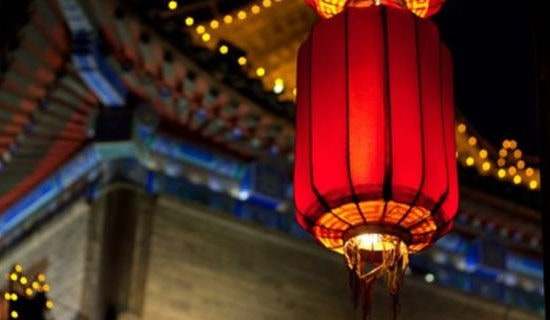春节的起源英文简介
春节对于中国人来说是最重要的节日。在每年的春节都让人兴高采烈,尤其是大年三十那晚,更是达到了高潮。下面是小编整理的春节的起源英文简介,欢迎阅读。

春节的起源英文简介 篇1
The Chinese New Year is now popularly known as the Spring Festival because it starts from the Begining of Spring (the first of the twenty-four terms in coodination with the changes of Nature). Its origin is too old to be traced. Several explanations are hanging around. All aGREe, however, that the word Nian, which in modern Chinese solely means "year", was originally the name of a monster beast that started to prey on people the night before the beginning of a new year.
One legend goes that the beast Nian had a very big mouth that would swallow a GREat many people with one bite. People were very scared. One day, an old man came to their rescue, offering to subdue Nian. To Nian he said, "I hear say that you are very capable, but can you swallow the other beasts of prey on earth instead of people who are by no means of your worthy opponents?" So, it did swallow many of the beasts of prey on earth that also harrassed people and their domestic animals from time to time.
After that, the old man disappeared riding the beast Nian. He turned out to be an immortal god. Now that Nian is gone and other beasts of prey are also scared into forests, people begin to enjoy their peaceful life. Before the old man left, he had told people to put up red paper decorations on their windows and doors at each year's end to scare away Nian in case it sneaked back again, because red is the color the beast feared the most.
From then on, the tradition of observing the conquest of Nian is carried on from generation to generation. The term "Guo Nian", which may mean "Survive the Nian" becomes today "Celebrate the (New) Year" as the word "guo" in Chinese having both the meaning of "pass-over" and "observe". The custom of putting up red paper and firing fire-crackers to scare away Nian should it have a chance to run loose is still around. However, people today have long forgotten why they are doing all this, except that they feel the color and the sound add to the excitement of the celebration.
中国的新年是现在俗称春节,因为它从立春开始(二十四个节气的第一个节气)。它的起源太老了,无法追踪。有好几种解释在周围徘徊。然而,所有人都同意,“现代”这个词在现代汉语中仅指“年”,最初是一个怪兽的名字,它在新年开始前的一个晚上开始捕食人们。
有个传说说,野兽年有一个非常大的嘴,将吞下许多人一口。人们非常害怕。有一天,一个老人来救他们,想制服Nian。他对Nian说:“我听说你很能干,但你能吞下地球上其他的猛兽,而不是那些不值得你尊敬的对手吗?”所以,它吞下了许多在地球上的猎物,也骚扰人民和他们的家畜不时的野兽。
之后,老人消失在野兽年。他原来是个不朽的神。现在Nian走了,其他猛兽也被吓到了森林,人们开始享受平静的生活。在老人离开之前,他曾告诉人们在每年的年底都要在窗户和门上挂上红纸装饰物,以防Nian再次溜回来,因为红色是野兽最害怕的颜色。
从那个时候起,观察“征服年”的.传统代代相传。“郭念”这一个词可能意味着“活年”,现在成为“庆祝”(新)一年,在汉语中的“郭”一词既有“传”和“观察”的意思。装红纸和放鞭炮来吓跑Nian的习俗,如果它有机会逃跑的话。然而,今天的人们早已忘记了他们为什么这么做,只是他们觉得色彩和声音增添了庆祝的兴奋。
春节的起源英文简介 篇2
The origin of the Chinese New Year is itself centuries old - in fact, too old to actually be traced. It is popularly recognised as the Spring Festival and celebrations last 15 days.
农历新年的起源是它几个世纪的历史岁月,事实上,这是由于年代过于久远而无法被准确的追溯。人们通常称之为春节并庆祝长达15天的时间。
Preparations tend to begin a month from the date of the Chinese New Year (similar to a Western Christmas), when people start buying presents, decoration materials, food and clothing.
准备的工作通常在农历新年(类似于西方的圣诞节)之前的一个月就已经展开,也就是人们开始购买礼物,装饰品,材料,衣服和食物。
A huge clean-up gets underway days before the New Year, when Chinese houses are cleaned from top to bottom, to sweep away any traces of bad luck, and doors and windowpanes are given a new coat of paint, usually red. The doors and windows are then decorated with paper cuts and couplets with themes such as happiness, wealth and longevity printed on them.
大扫除会在新年之前展开,华人的房屋会被彻底的打扫,扫去厄运,给门和窗子上新漆,通常都是红色的。在门和窗子上贴上剪纸和印有喜气,长寿,发财主体的对联。
The eve of the New Year is perhaps the most exciting part of the event, as anticipation creeps in. Here, traditions and rituals are very carefully observed in everything from food to clothing.
年三十夜或许是最激动人心的部分,如预期般的悄悄接近。这里,服装和食物上都体现着族传统礼仪的遵从。
Dinner is usually a feast of seafood and dumplings, signifying different good wishes. Delicacies include prawns, for liveliness and happiness, dried oysters (or ho xi), for all things good, raw fish salad or yu sheng to bring good luck and prosperity, Fai-hai (Angel Hair), an edible hair-like seaweed to bring prosperity, and dumplings boiled in water (Jiaozi) signifying a long-lost good wish for a family.
晚餐,通常都是饺子和海鲜酒席。象征着不同的美好祝愿,微妙的东西包括有虾来祝愿幸福快乐,干贝祝愿完事顺利,生鱼来祝愿好运和繁荣。Fai-hai 一种像头发般的可食用海藻带来繁荣的祝愿,水饺意味着对家庭的美好祝愿。
It's usual to wear something red as this colour is meant to ward off evil spirits - but black and white are out, as these are associated with mourning. After dinner, the family sit up for the night playing cards, board games or watching TV programmes dedicated to the occasion. At midnight, the sky is lit up by fireworks.
通常穿上红色的衣服,认为这种颜色可以避邪。但是绝不穿黑色和白色的。那些颜色通常和悲痛相联系。饭后家人们不睡,玩棋和打牌,看电视节目都融入于这种气氛。深夜,天空被烟花所点亮。
On the day itself, an ancient custom called Hong Bao, meaning Red Packet, takes place. This involves married couples giving children and unmarried adults money in red envelopes. Then the family begins to say greetings from door to door, first to their relatives and then their neighbours. Like the Western saying "let bygones be bygones," at Chinese New Year, grudges are very easily cast aside.
在农历新年当天,有一个古老的传统叫做红包,意思就是红色的小包。就是已婚的夫妇给小孩和未婚的成年人装在红信封里的钱。而后一家人开始串门问候,先去他们的亲戚家,而后是邻居。就如西方所说的,让过去的就成为过去吧。在农历新年,过去的过劫非常容易就被抛开了。
The end of the New Year is marked by the Festival of Lanterns, which is a celebration with singing, dancing and lantern shows.
新年的最后一天被称为灯笼节,以唱歌跳舞观灯笼的方式来庆祝。
Although celebrations of the Chinese New Year vary, the underlying message is one of peace and happiness for family members and friends.
虽然庆祝农历新年的方式很多,但其根本意义是,家庭和朋友的幸福快乐。
【春节的起源英文简介】相关文章:
清明节的起源简介04-05
元旦的由来英文版简介01-11
复活节的由来英文简介04-08
复活节的来历英文简介03-25
春节黑板报资料:春节起源与对联01-09
英文简历的基本要点基本简介04-28
春节简介黑板报范文01-09
中国元旦的起源10-11
关于元旦的起源变迁08-06
感恩节的起源10-12
